Johannis de Rijke facts for kids
Quick facts for kids
Johannis de Rijke
|
|
|---|---|
 |
|
| Born | December 5, 1842 |
| Died | January 20, 1913 (aged 70) |
| Nationality | Dutch |
| Occupation | Civil Engineer |
Johannis de Rijke (born December 5, 1842 – died January 20, 1913) was a skilled civil engineer from the Netherlands. He became a special advisor to the Japanese government during the Meiji period. He helped Japan with many important water projects.
Contents
Early Life and Learning
Johannis de Rijke was born in a place called Colijnsplaat on the island of Noord-Beveland. He was one of seven children. His father was a farmer and also worked on dikes, which are walls built to hold back water.
Johannis started working for the Dutch government as an apprentice. He learned a lot about math, building with earth, and how to manage water. This early training helped him become a great engineer.
Building a Career in Water Management
In 1865, De Rijke worked on a big project. He helped build the Oranje lock, which was a gate that controlled water flow. This lock helped close off the IJ bay from the Zuiderzee sea near Amsterdam. He was the main foreman on this important construction.
Later, in 1872, another engineer named Cornelis Johannes van Doorn invited De Rijke to join him in Japan. They were asked to help redesign the port of Osaka. This was a huge opportunity for De Rijke.
Making a Difference in Japan
De Rijke arrived in Japan in September 1873 with Van Doorn and George Arnold Escher. For the next 30 years, these three engineers worked on many projects. They focused on controlling floods and managing water systems.
Improving Ports and Harbors
De Rijke helped make many Japanese ports better. These included the ports of Tokyo, Yokohama, Nagasaki, Ujina (Hiroshima), Hakata (Fukuoka), Mikuni (Sakai), and Niigata. His work on the breakwater at the port of Yokkaichi is so important that the Japanese government recognizes it as a special cultural property.
Managing Rivers and Preventing Floods
De Rijke also created plans to improve the areas around several Japanese rivers. A very famous project was separating the Kiso River, Nagara River, and Ibi River near Nagoya. These are known as the Kiso Three Rivers (木曽三川, Kiso Sansen). This separation helped prevent floods.
He was also in charge of building a tunnel channel from Lake Biwa to Kyoto. This was a big engineering challenge. Additionally, he is known for building the sewer system for the Kanda River in Tokyo.
Working for the Japanese Government
After 1891, De Rijke became an Imperial officer in the Meiji Home Ministry. He rose to a high position, becoming a Vice Minister in the Japanese government. He also taught at the Imperial College of Engineering.
Helping Rivers in China
De Rijke's skills were needed beyond Japan. In 1876, he traveled to Shanghai to help make the Huangpu river easier for ships to use. This river is important for Shanghai's international trade.
He returned to Shanghai in 1897 to give another report on the Huangpu river. In 1901, he went back to China to work on a project to control floods on the Yellow River.
In 1906, he became the first chief engineer of the Whangpoo Conservancy Board. Before he went back to the Netherlands in 1909, he completed many river projects on the Huangpu river. This included building the Wusong Jetty and a new channel called Gaoqiao. His work successfully removed most of the shallow areas. This made the Huangpu river much deeper, allowing bigger ships to pass.
Later Life and Awards
De Rijke received many honors for his hard work. He was given the Order of the Sacred Treasures, a high award from Japan, in 1903. When he returned to the Netherlands, he was appointed an Officer of the Order of Orange-Nassau. In 1911, he became a Knight in the Order of the Dutch Lion. He was also knighted in the Order of Leopold in Belgium.
Johannis de Rijke passed away in Amsterdam at the age of 70. He is buried in the Zorgvlied cemetery in Amsterdam.
Honors and Recognitions
- Order of the Sacred Treasures, Japan (1889, 1892, 1903)
- Order of Orange-Nassau, Netherlands (1911)
- Order of the Dutch Lion, Netherlands (1913)
- Order of Leopold, Belgium


